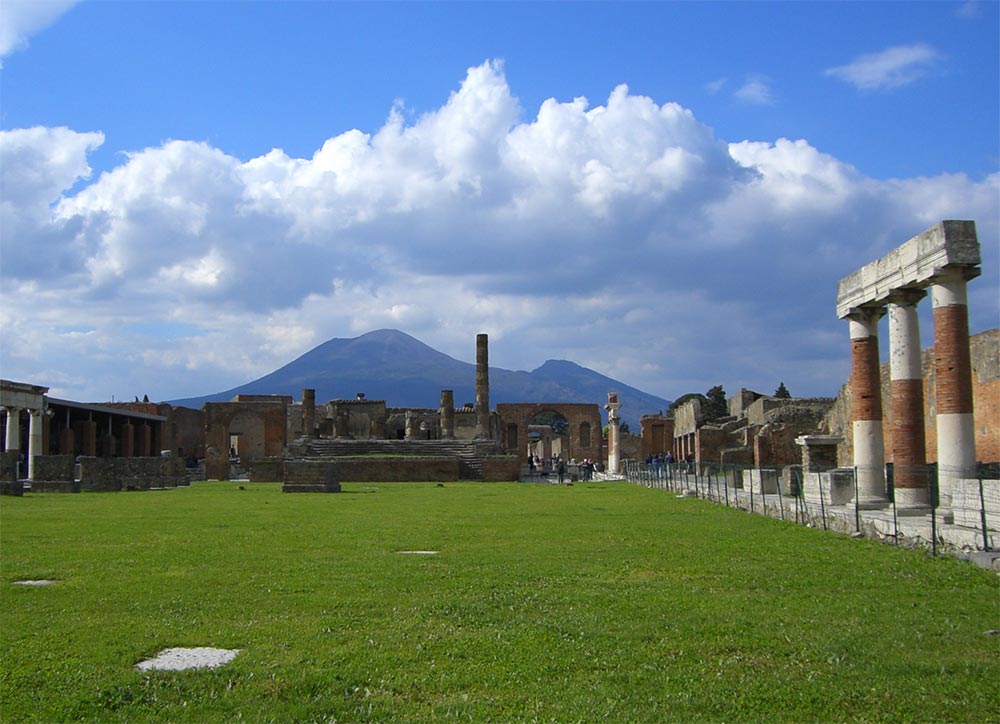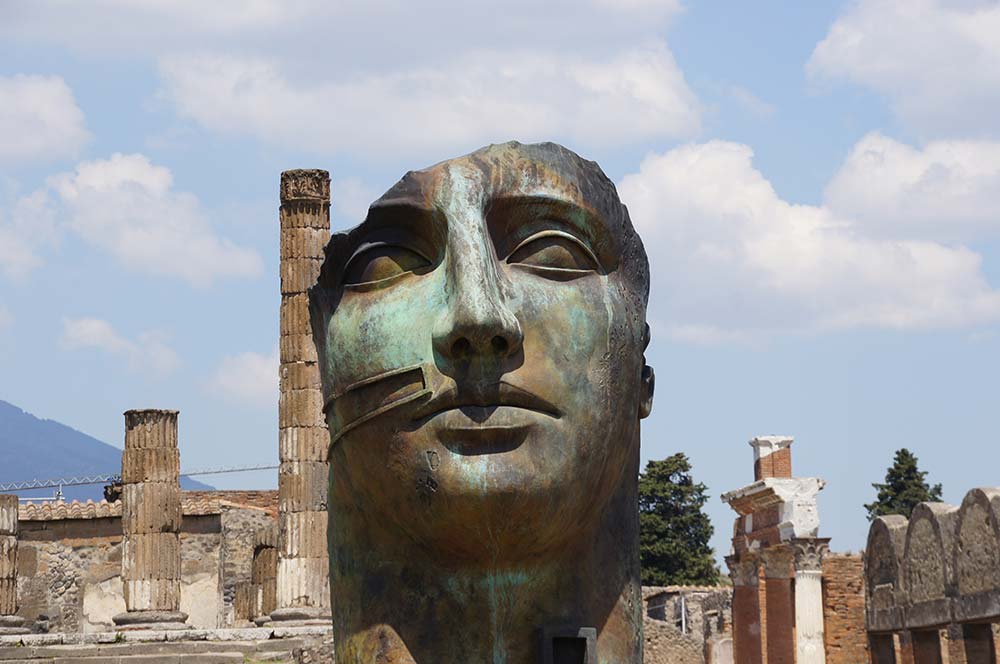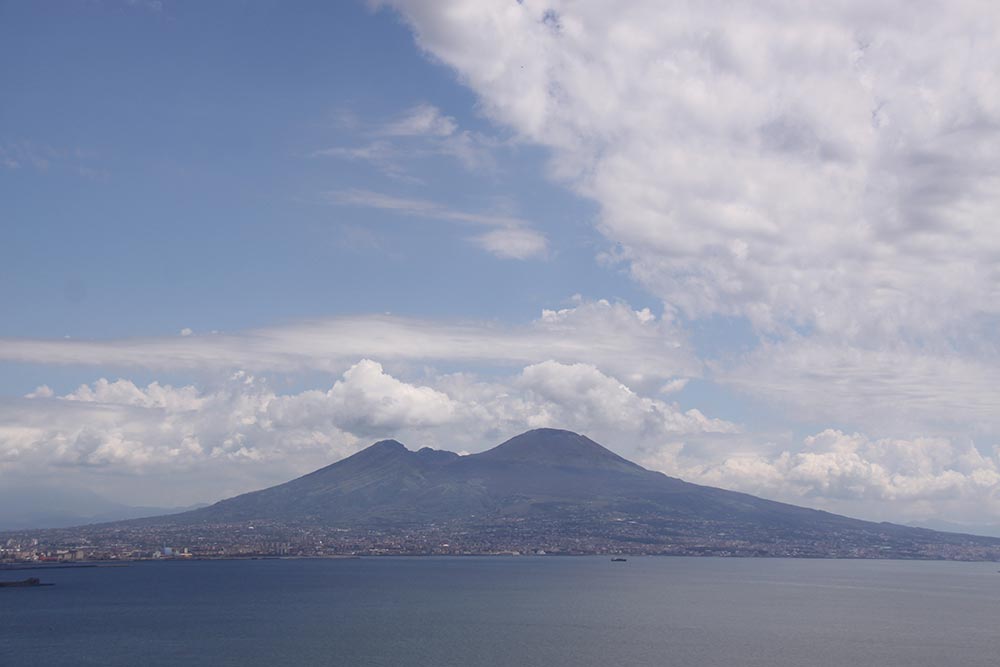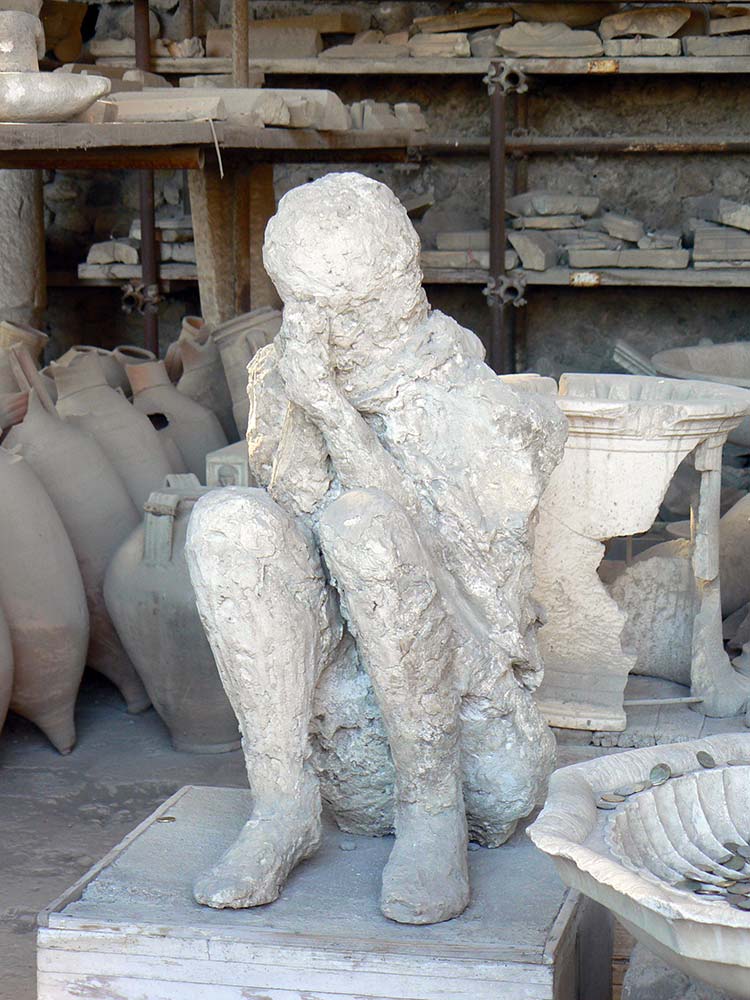Pompeii, Campania: visit the archeological site of this ancient city destroyed by the eruption of Vesuvius in 79 AD
Ready to know more about Pompeii? Here are our answers to the many questions about this fascinating archeological site. Ask away!
Where: Pompeii is located in Campania, Italy, on the slopes of Mount Vesuvius, less than a half an hour from Naples.

A bit of history: Books, movies, songs and much more have been written or based on Pompeii. The unexpected disaster that destroyed an entire city has always fascinated and tickled the imagination and curiosity of people that visit this amazing open-air museum. Why was this tragedy unexpected? Although a few years before there had been an earthquake in the area which had damaged Pompeii, its inhabitants did not expect that the mountain they used to represent in wall frescoes as a fertile lush area and hunting destination would actually turn out to be an active volcano.
Mount Vesuvius was not as we see it today, with a large and wide crater but it was just a mountain with a top that would collapse after this same tragic event.
At the time of the eruption the rebuilding of Pompeii was still in progress. The damages caused by the previous earthquake had been consistent and some of the wealthier citizens had already sold their villas and moved away out of fear of any other possible natural disasters. Even if less inhabited than before the earthquake, Pompeii, which was as big as 64 to 67 hectares (160 to 170 acres), was still a wealthy Roman resort city of around 12,000 people. It was later estimated that around 2,000 citizens were killed in the eruption. The construction work was also carried on because the water in the area had begun lacking, something quite odd for a city that had plenty of thermal baths and running water for the houses of the rich. Unknown to the population at the time, this was due to the volcano changing and damaging the underground with its small earthquakes prior to the eruption.
Pompeii of the past was a city adorned with beautiful villas, a sort of holiday residence for Romans and quite an important commercial center, with plenty of places to go shopping, eating and having fun, temples to visit and theaters where to enjoy open air performances. It is absolutely astonishing that all of that ended in the span of a few hours.

How did all these people die?
The whole process of the eruption lasted for two days and most of the Pompeiians were either intoxicated by the volcano’s fumes and ashes, buried under the rainstorm of pumice stones, volcano debris and lapilli, or faced the terrible and extreme high temperature that left them burnt alive. The whole site was then completely covered in meters high of volcanic debris.
Archeologists have identified that the eruption caught some people while in their sleep or carrying out everyday activities, others were trapped under collapsed buildings, and many were trying to escape from something terrible and unknown. The casts of their bodies or of animal bodies are testaments of their last moments, caught not with open mouths crying but grinding their teeth because of the high temperature.

When: The date of that ominous day usually quoted in books is most of the time incorrect. It was not August but the 24th of October 79 A.D. This has been deduced by an inscription on a wall in the site and by analyzing the coins that were used at the time. It’s quite fascinating how much Pompeii tells about itself in a way that makes it even more real to the modern visitor. For example, the many frescoes decorating the public buildings and houses tell us about the function of that space and the habits of their patrons, the everyday objects left behind and the food or jewelry tell us of the diverse social status of the inhabitants and they also convey how these people had our same fears and hopes. While escaping, many were carrying their valuables or hiding them. Some had pieces of jewelry representing their kids and loved ones, some died while holding their babies or in their bed because they were old and fragile and could not move. Villas, shops, public baths, theatres, main square, gymnasium, factories, cafes, taverns and even a brothel give us abundant details about their proper function and about the customs of all kinds of people, from slaves to merchants to the more privileged members of society.
Pliny the Younger, who twenty-five years later wrote in two letters about the death in Pompeii of his uncle Pliny the Elder, is one of the most important witnesses of his time. He was in Capo Miseno, around 60 km away from Pompeii, and he describes what today is called after his same name: a “Plinian eruption”.
The day before the eruption the earth had begun to shake. On the same day at noon a huge column of almost fifteen kilometers (12 miles) that he could clearly see from far away, composed by volcanic debris and hot gasses shot into the stratosphere. For twelve hours that sort of gigantic umbrella pine tree (as Pliny describes it) was kept aloft by its own force, permitting a part of the people of Pompeii and nearby towns to escape. Pliny the Younger said that as the clouds obscured the sun many thought this was going to be the world’s last eternal night. People were witnessing a gigantic dark cloud coming towards them, surrounded by loud noises, lighting and electrical charges alongside the rain of pumice stones and debris that started to fall on the city and nearby. In a few hours the roofs of the houses collapsed under the weight of this incredible rainstorm, the air was full of smoke and dark fumes, daylight disappeared, people still inside the city were hiding or trying to find shelter.
During the night the nearby port of Herculaneum waited in vain for help as the rough sea conditions did not allow any escape. These people were then submerged first by mud then by incredibly fast surges of hot ashes and toxic gas. The same fate awaited Pompeii. As its citizens felt reassured enough to get out of their covers, they were hit by the destructive power of hot ash, burning gasses and liquified rocks coming at an unbearable speed and heat, surges which ended their lives on the spot.
Aftermath: When the Romans and the survivors came back to see what had happened to Pompeii and Herculaneum, these cities seemed to have disappeared. The area where they were supposed to be located was covered by meters high of debris. At the time and in the following years there were attempts to dig up these places, but nobody did it systematically and fully understood what was underneath until 1700, when, looking for the old city of Stabiae, archeologists brought Pompeii back to light.
Today the most interesting pieces found in Pompeii are on display at Mann (Museo Archeologico Nazionale di Napoli, Naples National Archeological Museum). Artifacts such as statues, busts, frescoes, silver and bronze objects and mosaics, like the Alexander mosaic taken from the House of Faun in Pompeii, provide an idea of a lively and culturally active civilization. Also visible are the erotic paintings and representation found on walls or floors of Pompeii’s lupanari (brothel) and thermal baths.

During these years of studies, archeologists found a way to preserve the many silhouettes of Pompeii’s victims found under the debris. The casts of these people that tried to escape their fate were made by filling the hollow parts left by the bodies on the debris and pouring inside liquid chalk, as a sort of mold. The most touching of these casts can be found at the Orto dei Fuggiaschi, the Garden of the Fugitives, where the vision of their helpless bodies is just heartbreaking. These lifeless shapes, including those of animals, forever staying immobile, part of a cruel still life, leave visitors overwhelmed with empathy for their fate, an experience that cannot be felt in any other archeological sites. They have been forever immortalized and the exterior details of their dresses, jewelry and appearance not only are of historical importance but they also touch our personal chords.
Today: Are there more sites that underwent the same fatal fate of Pompeii in the area? Have these areas been fully unveiled? What can you visit today in Pompeii?
As far as the first question is concerned, Pompeii shared its tragic destiny with Herculaneum, Stabiae and Oplontis, each characterized by its own distinctive and interesting archeological sites. What differentiates Pompei with the others is the vastness of the city as well as the many different types of building that can be seen there. These archeological sites are not fully unearthed; new and modern cities were built on top of the previous ones, making it impossible to completely bring to the light the whole ancient locations. Every now and then there are new findings, even on some present sites you could find deviations to the route suggested which might indicate that further investigation is being brought onto the already visible ruins. Needless to say, Pompeii is an archeological site included in UNESCO’s heritage treasures.
In a visit to Pompeii, you have to take into consideration that you will actually see a whole city, with all that it entails. You will see public buildings, commercial ones and private lodgings. The Forum is the main square, the monumental Basilica is the place where justice was administered, the temple of Apollo was one of the religious temples, and at the same time there are many business activities, like bakeries, inns, bars, and some offices like the practice of a surgeon. There are buildings that functioned as places where people gathered, such as the thermal baths, designed with different rooms dedicated to diverse activities, decorated with beautiful ornate walls. There are theaters and amphitheaters which could seat thousands of people to watch shows like fights between gladiators.
Many private houses have also been preserved. One of the most remarkable ones, Casa del Fauno (The House of the Faun), so called because of the dancing faun statue decorating the inside, is the one that had the most beautiful mosaics. These kinds of decorations, as well as painted rooms, columns, fountains statues, busts and everything that was necessary to embellish a private residence and impress the guests are a common trait of all the private and public buildings, such as the House of Menander, the House of the Vettii, House of Venus in a shell and so on. These buildings take their name, in most cases, after the decorations or artifacts found inside or, in a few cases, from the possible owner. Frequently, rooms were painted with bright hues and drawings representing the space’s function, telling the story of a myth or something about the same residents that we have completely lost today. Impressive are the colors used in the decorations, like the famous Pompeian red.
Most of the places enlighten us on the habits and objects used at the time and give us an insight into how crucial a residence’s appearance was for citizens of Pompeii. Visiting them, we also gain an understanding of those that were the customs of Pompeiians, such as the lupanare, the brothel that, when discovered, shocked archeologists so much that it was kept hidden for almost a century. The space includes not only erotic frescoes on its walls but also celebratory graffiti depicting customers praising girls and boys working in those rooms and even love messages, which teach us about the hard life of the workers and the concept of love and sex of the time.
Another worthy mention are the mesmerizing frescoes at the so-called Villa dei Misteri, Villa of the Mysteries. It is just what you might have seen in many history books but did not know where it came from: a beautiful representation of life-sized figures, where a lady that is prepared for the conversion to a cult is being dressed and combed. Her face is so modern and expressive, her clothing and hairdo so defined and delicate that it almost gives you a sense of déjà-vu.
This is just a brief list of what Pompeii can reveal to a visitor, there are so many beautiful and amazing treasures that you will need to take it slow and spend many hours in this archeological site. In case you are still wondering what it was like for wealthy people to live in Pompeii, the House of Menander is just what you need to dispel any doubts: private baths, an enjoyable courtyard filled with aromatic plants and walls decorated to leave you in awe. It seems that the owner was related to Poppea, the wife of emperor Nero. Not bad for a relative.
How to get there: Be equipped before getting there, the site is big and there will be a lot of walking to do. Comfortable shoes, sunscreen, hats and water. No vendors are allowed inside, camera flashes aren’t allowed either. The walk can be uneven so not suitable for strollers or prams. Try to visit it in the early hours of the morning as it can get quite hot. An audio guide is a good idea, a guided tour would make your visit more effective and interesting. The circumvesuviana train takes you there from Naples. As said, this is not the only archeological site of the area; Herculaneum, Stabia and Oplontis offer lots as well. On the official website you can check the times, download the maps, buy your ticket and it is in many languages: http://pompeiisites.org/
We started our narration with the story of Pliny the Younger who was reporting to a friend about the event and the saddening death of his uncle, Pliny the Eldest. What happened to him? Pliny the Eldest was a writer, philosopher and Roman admiral who, when asked to help by some friends, did not hesitate to put his fleet to disposition of the people running from the eruption and to go there himself. It was the first rescue of civilians by military means in history, the first true act of civil defense in history. Unfortunately, he too was not spared by the toxic fumes of the Volcano and died shortly after. In this tragedy a famous victim and common people are united and today we have the chance to see from up close so that the distance between the victims of 79 AD and us is completely erased.